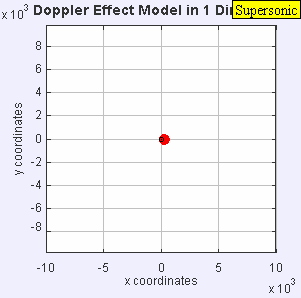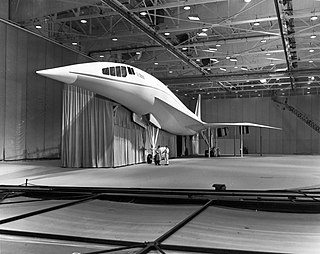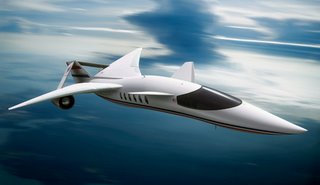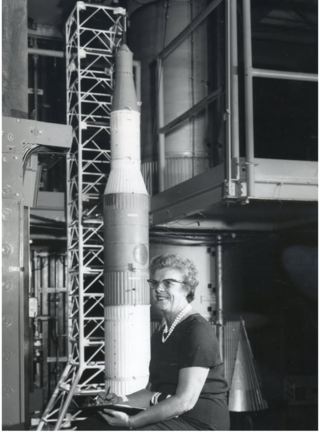
Concorde is a retired Franco-British supersonic airliner jointly developed and manufactured by Sud Aviation and the British Aircraft Corporation (BAC). Studies started in 1954, and France and the UK signed a treaty establishing the development project on 29 November 1962, as the programme cost was estimated at £70 million . Construction of the six prototypes began in February 1965, and the first flight took off from Toulouse on 2 March 1969. The market was predicted for 350 aircraft, and the manufacturers received up to 100 option orders from many major airlines. On 9 October 1975, it received its French Certificate of Airworthiness, and from the UK CAA on 5 December.

The sound barrier or sonic barrier is the large increase in aerodynamic drag and other undesirable effects experienced by an aircraft or other object when it approaches the speed of sound. When aircraft first approached the speed of sound, these effects were seen as constituting a barrier, making faster speeds very difficult or impossible. The term sound barrier is still sometimes used today to refer to aircraft approaching supersonic flight in this high drag regime. Flying faster than sound produces a sonic boom.

The Boeing 2707 was an American supersonic passenger airliner project during the 1960s. After winning a competition for a government-funded contract to build an American supersonic airliner, Boeing began development at its facilities in Seattle, Washington. The design emerged as a large aircraft with seating for 250 to 300 passengers and cruise speeds of approximately Mach 3. It was intended to be much larger and faster than competing supersonic transport (SST) designs such as Concorde.

A sonic boom is a sound associated with shock waves created when an object travels through the air faster than the speed of sound. Sonic booms generate enormous amounts of sound energy, sounding similar to an explosion or a thunderclap to the human ear.

The North American Aviation XB-70 Valkyrie is a retired prototype version of the planned B-70 nuclear-armed, deep-penetration supersonic strategic bomber for the United States Air Force Strategic Air Command. Designed in the late 1950s by North American Aviation (NAA), the six-engined Valkyrie was capable of cruising for thousands of miles at Mach 3+ while flying at 70,000 feet (21,000 m). It was designed to replace the B-52 Stratofortress and B-58 Hustler, and utilizes a delta wing.

A supersonic transport (SST) or a supersonic airliner is a civilian supersonic aircraft designed to transport passengers at speeds greater than the speed of sound. To date, the only SSTs to see regular service have been Concorde and the Tupolev Tu-144. The last passenger flight of the Tu-144 was in June 1978 and it was last flown in 1999 by NASA. Concorde's last commercial flight was in October 2003, with a November 26, 2003 ferry flight being its last airborne operation. Following the permanent cessation of flying by Concorde, there are no remaining SSTs in commercial service. Several companies have each proposed a supersonic business jet, which may bring supersonic transport back again.

The Lockheed L-2000 was Lockheed Corporation's entry in a government-funded competition to build the United States' first supersonic airliner in the 1960s. The L-2000 lost the contract to the Boeing 2707, but that competing design was ultimately canceled for political, environmental and economic reasons.
The history of Oklahoma City refers to the history of city of Oklahoma City, and the land on which it developed. Oklahoma City's history begins with the settlement of "unassigned lands" in the region in the 1880s, and continues with the city's development through statehood, World War I and the Oklahoma City bombing.

The NASA Shaped Sonic Boom Demonstration, also known as the Shaped Sonic Boom Experiment, was a two-year program that used a Northrop F-5E with a modified fuselage to demonstrate that the aircraft's shock wave, and accompanying sonic boom, can be shaped, and thereby reduced. The program was a joint effort between NASA's Langley Research Center, Dryden Flight Research Center at Edwards Air Force Base, California and Northrop Grumman.

A supersonic aircraft is an aircraft capable of supersonic flight, that is, flying faster than the speed of sound. Supersonic aircraft were developed in the second half of the twentieth century. Supersonic aircraft have been used for research and military purposes, but only two supersonic aircraft, the Tupolev Tu-144 and the Concorde, ever entered service for civil use as airliners. Fighter jets are the most common example of supersonic aircraft.
NORC at the University of Chicago is one of the largest independent social research organizations in the United States. Established in 1941 as the National Opinion Research Center, its corporate headquarters is located in downtown Chicago, with offices in several other locations throughout the United States. Organized as an independent corporation, more than half its board comes from faculty and administration of the University of Chicago. It also jointly staffs some of the university's academic research centers.

The SAI Quiet Supersonic Transport (QSST) was a project by Supersonic Aerospace International (SAI) to develop a "virtually boomless" commercial supersonic business jet. The project was announced around the year 2000 and provided update announcements until 2010. After three years without any updates, the last update was in 2013. As of 2023, there have been no more updates, and the project appears to have been abandoned.

Quiet Spike was a collaborative program between Gulfstream Aerospace and NASA's Dryden Flight Research Center to investigate the suppression of sonic booms. The patent was published with the United States Patent and Trademark Office in 2004 and is owned by Gulfstream Aerospace.

The High Speed Civil Transport (HSCT) was the focus of the NASA High-Speed Research (HSR) program, which intended to develop the technology needed to design and build a supersonic transport that would be environmentally acceptable and economically feasible. The aircraft was to be a future supersonic passenger aircraft, baselined to cruise at Mach 2.4, or more than twice the speed of sound. The project started in 1990 and ended in 1999.
The Gulfstream X-54 is a proposed research and demonstration aircraft, under development in the United States by Gulfstream Aerospace for NASA, that is planned for use in sonic boom and supersonic transport research.

The Anti-Concorde Project, founded by environmental activist Richard Wiggs, challenged the idea of supersonic passenger transport, and curtailed Concorde's commercial prospects. When Concorde entered service in 1976, of the 74 options held at the time of the first flight, only those for the state airlines of Britain (BOAC) and France were taken up, so that only 20 were built, although flights were also flown for Braniff International and Singapore Airlines. It triggered research into the factors affecting the creation of sonic booms, which led to the Shaped Sonic Boom Demonstration which achieved their goal of reducing the intensity of sonic booms, and echoed public concern about aircraft noise that resulted in more restrictive noise limits for aircraft and airport operations, as well as changes in both operating procedures and aircraft design to further reduce noise levels.
Douglas Aircraft Company's Model 2229 was a proposed supersonic transport (SST) originally started as a private study. The design progressed as far as making mock-ups of the cockpit area and wind-tunnel models of the overall layout. After studying the design, Douglas concluded that the SST would not work economically, and declined to enter the Model 2229 in the National Supersonic Transport (NST) program in 1963.

The Lockheed Martin X-59 Quesst, sometimes styled QueSST, is an American experimental supersonic aircraft being developed at Skunk Works for NASA's Low-Boom Flight Demonstrator project. Preliminary design started in February 2016, with the X-59 planned to begin flight testing in 2021. After delays, as of January 2024, it is planned to be delivered to NASA for flight testing in 2024. It is expected to cruise at Mach 1.42 at an altitude of 55,000 ft (16,800 m), creating a low 75 effective perceived noise level (EPNdB) thump to evaluate supersonic transport acceptability.

The Boom Overture is a proposed Mach 1.7, 64–80 passenger supersonic airliner with 4,250 nmi of range, which is planned to be introduced in 2029 by Boom Technology. The company claims that with 500 viable routes, there could be a market for 1,000 supersonic airliners with business class fares. It had gathered 76 commitments by December 2017. The aircraft is planned to have a delta wing configuration, but will be built with composite materials. Following a redesign revealed in 2022 it is intended to be powered by four dry (non-afterburning) 35,000 lbf (160 kN) turbofans. Regulations for takeoff noise or overland boom can be met or changed.

Vera Huckel (1908–1999) was an American mathematician and aerospace engineer and one of the first female "computers" at NACA, now NASA, where she mainly worked in the Dynamic Loads Division.

















